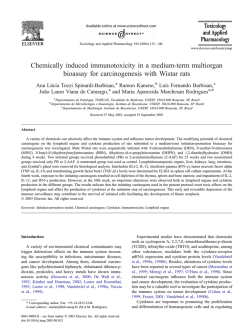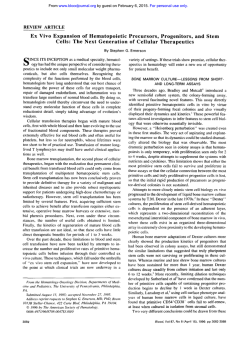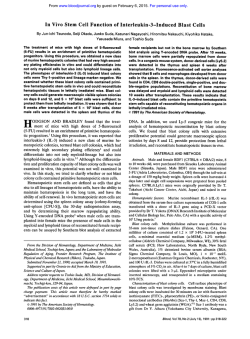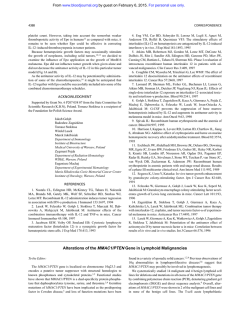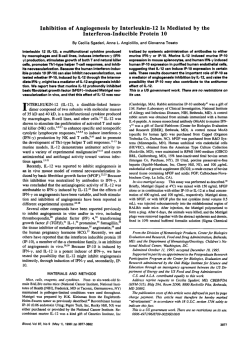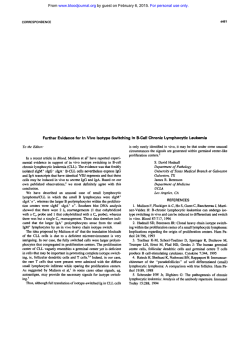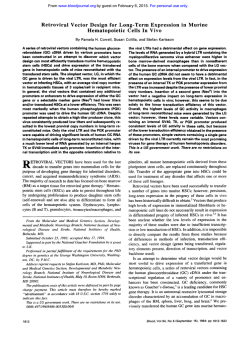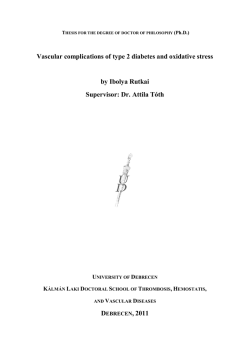
Interleukin-l2 Enhances Peripheral Hematopoiesis In Vivo
From www.bloodjournal.org by guest on February 6, 2015. For personal use only. Interleukin-l2 Enhances Peripheral Hematopoiesis In Vivo By John D. Jackson, Yun Yan, Michael J. Brunda, Linda S. Kelsey, and James E. Talmadge lnterleukin 12 (IL-12) is a cytokine that supports the proliferation and activation of cytotoxic T lymphocytes and natural killer (NK) cells. Recent evidence has suggested that IL-12 also has hematopoietic activities in vitro. We report studies that show that IL-12 has significant in vivo hematopoietic stimulating activity that includes enhancementof peripheral (splenic) hematopoiesis and mobilization of hematopoietic progenitor cells to the peripheral circulation.A single injection of recombinant murine IL-12 significantly reduced the number of bone marrow (BM) colony-forming unit granulocyte-macrophage (CFU-GM) in a time-dependent manner, while concomitantly stimulating high proliferativepotential. In contrast, splenic CFU-GM and HPP were increased in a time- and dose-dependent manner. Chronic administration of IL-12 resulted in significant splenic hyperplasia with increasedprogenitorcells,increasedcirculatingprogenitor cells, and BM hypoplasia with decreased progenitor cells. These data show that IL-12 has significant in vivo hematopoietic effectsthat includethe ability to mobilize progenitor cells to the peripheral circulation, which may prove to be of significantbenefit for peripheral blood stem cell transplantation. Thus, IL-12 has potential to be an important agent for clinicaltransplantationbecause of its hematopoieticmobilization and its previously shown immune augmenting and therapeuticactivities.Thiscombinationofhematopoietic and immune functions is unique and not achievable with currently used hematopoietic growth factors. 0 1995 by The American Societyof Hematology. I toneal injections of 1 pglanimal IL-12 for 3 or 7 days. Organ cellularities and hematopoietic progenitor cells were evaluated as described below. Tissue preparation. Femurs were removed from the mice and the marrow plug aseptically flushed into RPM1 1640 containing 3% fetal bovine serum (FBS), 1 0 0 U penicillin, and 100 pg streptomycin using a syringe fitted with a 2 l-gauge needle. A single cell suspension was prepared by repeated gentle aspirations of the marrow plug using the same syringe. The cells were counted and plated in colony assays. Spleens were removed aseptically and extraneous tissue was dissected away, placed in cold Hanks’ balanced salt solution (HBSS) and minced into a tissue sieve. A disposable syringe plunger was used to press the cells through a stainless steel grid to form a cell suspension. A single cell suspension of nucleated cells was obtained after filtration through a Nytex filter. The cells were counted and plated in colony assays. Peripheral blood was obtained via the retro-orbital plexus using heparinized Pasteur pipettes from anesthetized mice. To facilitate blood collection, the mice were injected with 100 units heparin 30 minutes before bleeding. White blood cell (WBC), redblood cell (RBC), and platelet counts were determined using a Serono Baker Model 9000 blood analyzer. A peripheral blood smear was prepared and stained with Wright’s-Giemsa stain for differential counts. For the determination of hematopoietic progenitor mobilization to the peripheral circulation, mice were exsanguinated via the brachial artery. Peripheral blood from two mice were combined and mononuclear cells isolated by centrifugation through Lymphocyte M density gradient (Cedarlane, Homby, Ontario, Canada). Cells were washed and plated in colony assays. NTERLEUKIN-12 (IL-12) is a recently identified cytokine that isproduced by macrophages and B cells.’ Originally, IL-12 was described as a natural killer cell stimulating factor and cytotoxic lymphocyte maturation factor.2z3Recent evidence suggests that IL-12 is important in controlling immune responses? IL- 12 enhances cell-mediated responses while suppressing antibody responses by preferentially stimulating Thl cell populations and inhibiting the induction of Th2 cell population^.^" In mouse metastatic tumor models, IL-12 was effective in reducing the growth and metastases of several tumors.’ Inaddition to its immunologic and antitumor activities, IL-12 has been shown to have in vitro effects on hematopoietic stem and progenitor cells.’ Although IL12 alone cannot stimulate hematopoietic progenitor colony formation in vitro, synergy in colony formation was noted when combined with other cytokines.’”’ In short-term liquid cultures of hematopoietic cells, IL-12 interacted with other cytokines in a synergistic manner to enhance the production of hematopoietic stem and progenitor cells.” Therefore, not only is IL- 12 an immunologically active cytokine, but IL12 is also a hematopoietically active cytokine in vitro. In this study, we examined the in vivo hematopoietic effects of IL-12 in normal and splenectomized hematopoietically competent mice and show that IL-12 is a potent agent for the in vivo mobilization of hematopoietic progenitor cells to the periphery. MATERIALS AND METHODS Animals. Normaland splenectomized female Balblc-ANN mice were purchased from Charles River (Wilmington, MA). The mice were housed in laminar flow units and given irradiated foodand acidified water (pH 2.5) ad libitum. Mice were acclimated for at least 2 weeks before use in any experiments. IL-12. Recombinant mouse IL-12 was supplied by HoffmannLaRoche (Nutley, NJ). In the time course study, mice received a single intraperitoneal injection with 1 pg IL-12.At various times ( I , 2, 3, or 4 days) after IL-12 treatment, mice were killed and hematopoietic parameters from bone marrow, spleen, and peripheral blood were determined. In the dose response experiment, mice received a single intraperitoneal injection with 0.001, 0.01, 0.1, I , or 3 &animal of IL- 12. Control mice received saline injections. Three days after treatment, femurs and spleens were removed and organ cellularities and progenitor content were assessed. To determine the effects of multiple exposures to IL-12, mice received daily intraperi- Blood, Vol85, No 9 (May l ) , 1995 pp 2371-2376 From the Department of Pathology and Microbiology, University of Nebraska Medical Center and Department of Oncology, Hoffmann-LaRoche Inc. Submitted June 13, 1994; accepted December 8, 1994. Supported in part by Nebraska Department of Health Grant No. 93-49. Address reprint requests to John D. Jackson, PhD, Department of Pathology and Microbiology, University of Nebraska Medical Center, 600 S 42nd St, Omaha, NE 68198-3135. The publication costs of this article were defrayed in part by page charge payment. This article must therefore be hereby marked “advertisement” in accordance with I8 U.S.C. section 1734 solely to indicate this fact. 0 1995 by The American Society of Hematology. 0006-4971/95/8509-06$3.00/0 2371 From www.bloodjournal.org by guest on February 6, 2015. For personal use only. JACKSON ET AL 2312 - 200 Colony-forming unit g r a n u l ~ ~ c ~ t e - m a c r o p(CFU-GM) l~a~~e c~ssny. Bone marrow (BM), spleen, or peripheral blood cells were plated at a concentration of I X IO'. S X I o ' or I X IO" cells/dish, respectively in 35-mm dishes containing Iscove's modified Dulbecco's medium (IMDM). 0.3% agar. 15% FBS. I O 0 U penicillin. I O 0 pg streptomycin, 5 X M 2-mercaptoethanol and I O nglmL recombinant mouse 1L-3 (Biosource International, Camarillo. CA) as a source of colony-stimulating activity. Dishes were incubated for 7 days at 37°C in a humidified atmosphere containing 5% COz in air. The colonies were enumerated using an inverted microscope. Groups of SO or more cells were counted as colonies. High proliferative potential( H P P ) ossay. BM, spleen. or peripheral blood cells were plated at a concentration of I X IO', S X IO'. or I X IO5 cellddish respectively, in 35-mm dishes containing IMDM. 0.3% agar. 15% FBS. S X IO" M2-mercaptoethanol, IO nglmL IL-3 (Biosource International, Camarillo. CA), and 10% Lcell-conditioned medium as sources of colony-stimulating activity. Dishes were incubated for 1 1 days at 37°C in a humidified atmosphere containing S 8 CO2 in air. The colonies were enumerated using an inverted microscope. Cell aggregates greater than 1 mm in diameter were counted as HPP colonies. Stntistics. Each study was repeated two or more times and each group in each study was examined in triplicate. All samples were plated in triplicate for the in vitro colony assays. Statistical significance between groups was determined by one-way analysis of variance.and all pairwise mulfiple comparisons were determined by using the Student-Newman-Keds method. A P value of .OS or less was considered significant. l0 8 l00 6 -50 zk 35000 L Q) .-gg 0 0 30000 25000 20000 15000 10000 5000 0 2 P 2.- Q) O 0% Q) Q) P v) 2 0 40000 ='(0C - 4 RESULTS In studies to determine the time course of IL-12hematopoietic effects, mice received a single bolus injection of I yglanimal of recombinant murine IL- and 12 were evaluated for hematopoietic parameters I , 2, 3, and 4 days postinjection. No effect was noted on WBC, RBC, or platelets. However, the percentof monocytes increased on days 2 and 3 post IL-12 treatment (data not shown). Neither BM norspleen cellularities were altered by a single injection of IL-12(Fig IA). No effect on BM CFU-GM was noted except at the later time point (day 4),which showed a significant decrease (Fig IB). In contrast, BM HPP increased on day 3 after IL12 administration suggesting differential effects of IL-12on early versus late hematopoietic progenitor cells. Furthermore, the number of splenic CFU-GM and HPP increased in a time-dependent manner. The number of progenitor cells peaked on day 3 postinjection and began decreasing on day 4 (Fig IC). Using the time-dependent results from the previous experiment, a dose-response study was performed. Normal mice received a single bolus intraperitoneal injection with doses of IL-12 ranging from 0.001 to 3 pg/animal. Three days after IL-12treatment, the peripheral blood, BM, and spleen were examined for hematologic and hematopoietic parameters. No significant effects were noted on peripheral WBC, RBC, or platelets numbers. The percent of monocytes significantly increased to 6% at doses of 1 and 3 pg IL-12as compared to I % in control mice. No significant change in BM or spleen cellularity was noted (Fig 2A). BM CFU-GM was not affected by a single injection of IL-12at any dose; however, BM HPP was significantly increased at the higher - -0 , D l i 7 0CFU-GM m HPP 4000 3000 Q) -g 2000 0 0 1000 control l 2 3 4 Days Post IL-l2 Treatment Fig 1. Timecourse study of 11-12 in vivo. Mice received a single intraperitoneal injection of 1 pglanimal 11-12 At various times postinjection, the number of CFU-GM, HPP, and cellularities from bone marrow and spleen was determined. (A) BMand spleen cellularities, (B) BM CFU-GM andHPP, IC) spleen CFU-GM andHPP. Data are presented as mean t SEM. 'Represents P I.OS. doses ( I and 3 pglanimal) of IL-12. Again, this indicates a differential effect of IL-12 on early versus more mature BM progenitor cell populations. Although there was no effect on spleen cellularity, the number of splenic CFU-GM and HPP increased at higher IL-12doses (Fig 2C). In the chronic administration studies, micereceived IL12 for 3 or 7 consecutive days by intraperitoneal injection of I ,&animal IL-12.There was a 50% decrease in peripheral WBC (4.4X IO' to 2.4 X I03/mm3)after 7 days of IL12 treatment, but no effect on RBC or platelets was noted. The percent of peripheralblood lymphocytes was signifi- From www.bloodjournal.org by guest on February 6, 2015. For personal use only. 2373 IL-12 MOBILIZATION , 300 14 , B 0CFUGM m HPP T * number of circulating progenitor cells in peripheral blood was determined. Because the spleen is a hematopoietic organ in the mouse, splenectomized mice were also used to show the mobilization properties of IL-12. The number of circulating hematopoietic progenitor cells was assessed in the peripheral blood of normal and splenectomized mice after 7 days of 1L-12 treatment. Circulating progenitor cells were not detected in the control mice because of the low frequency of circulating progenitor cells. When the spleen-containing mice were treated with IL-12, the number of CFU-GM and HPP increased to S6 and 80 colonies per total blood volume, respectively (Fig S ) . In splenectomized mice,the baseline CFU-GM and HPP were 2 and 4 colonies per total blood volume, respectively. When the splenectomized micere- A 0Control 3 Days of IL-l2 Treatment 7 Days of IL-l2 Treatment Granulocyte C 0CFU-GM m HPP h T 0 20 10 40 30 50 60 70 80 90 100 Cell Differential (%) Control 0.001 0.01 0.1 l 3 Days of IL-l2 Treatment 7 Days of IL-12 Treatment IL-12 Dose (pg) Fig 2. Dose-response study ofIL-12 in vivo. Mice received a single intraperitoneal injection of the various doses of IL-12. Three days postinjection, the number of CFU-GM, HPP, and organ cellularities were determined. (AI bone marrowand spleen cellularities, (B) bone marrow CFU-GM and HPP, (C) spleen CFU-GM and HPP. Data are presented as mean ? SEM. *Represents P I .05. cantly decreased, whereas the percent of granulocytes and monocytes were significantly increased at the two treatment times (Fig 3A). The absolute number of monocytes was significantly increased and the absolute number of lymphocytes was significantly decreased, whereas the absolute number of granulocytes did not change significantly after 3 and 7 days of IL-12 treatment (Fig 3B). Femur cellularities were decreased and spleen cellularities were increased in a timedependent manner (Fig 4A). The number of CFU-GM and HPP per femur was decreased after 3 and 7 days treatment with IL-12 (Fig 4B) with a concomitant increase in spleen CFU-GM and HPP (Fig 4C) suggesting a mobilization effect of IL-12. To directly evaluate the mobilizing effects of IL-12, the B 0Control 3 Granulocyte P Lymphocyte I 0 l I l I l 3000 4000 5000 6000 71 Absolute Numberof Cells 1000 2000 K) Fig 3. Peripheral blood differential and absolute numbers after chronic 11-12treatment. Micereceived daily intraperitoneal injections of 1 pglanimal of IL-l2 3for or 7 days. Peripheral blood was removed from the retro-orbital plexus form anesthetized mice and blood smears prepared. Slide were stained using Wright's and Giemsa stain and a 200-cell differential counted. Absolute cell numbers were calculated from the differential and WBC counts. (A) Peripheral blood cell differential, and (B) absolute peripheral blood cellnumbers. Data are presented as mean ? SEM. Represents P I .05. From www.bloodjournal.org by guest on February 6, 2015. For personal use only. JACKSON ET AL 2374 ceived IL-12for 7 days, the number of CFU-GM and HPP colonies per total blood volume increased to 140 and 163, respectively (Fig 5). The total blood volume calculation was basedon 5.85 mL bloodper 100 g body weight for the mouse.I3 The dramatic increase in circulating progenitor cells after IL-I2 treatment shows the potentmobilizing activity of IL-12. 0CNOY Fma HPP Control IL-l2 I Splenectomkd Control DISCUSSION I l In these studies, we examined the in vivo effects of IL- I2 Splenoctornlzed IL-l2 in hematopoietically intact mice. Time- and dose-response studies as well as chronic administration studies were per- *I b--"------l 40 80 120 180 200 240 Colonies/Total Peripheral Blood Volume 12 . r 500 Fig 5. Effects of chronic exposureof IL-12 on circulating peripheral blood hematopoietic progenitor cells in normal and splenectomized mice. Mice received daily intraperitoneal injections of 1 pglanimal of IL-l2 for 7 days. Data are presented as mean f SEM. *Represents P S .05. -0 50000 0CFU-GM HPP 4 l0000 0 0 3 7 Days of IL-l2Treatment Fig 4. Effects of chronic exposure of 11-12 on bone manow and spleen hematopoietic progenitor cells. Mice received daily intraperitoneal injections of 1 pglanimal of11-12 for 3 or 7 days. (A) bone marrow and spleen cellularities,(B) bone marrow CFU-GM and HPP, (C) spleen CFU-GM and HPP. Data are presented as mean SEM. *Represents P I .05. * formed. We report that the administration of a single bolus injection of 1 pg/animal of IL-12 reduced the numberof CFU-GM and increased the number of HPP in the BM and increased the number of splenic CFU-GM and HPP at 3 days postinjection (Fig 1, B and C, and 2,B and C). These findings confirm the observations from another study that showed a decrease in BM C N - G M and anincrease in spleen CFU-GM after multiple injections of IL-l2.I4.l5 Additionally, the data show that IL-12 has differential effects on early (HPP) versus late (CFU-GM)BM progenitor populations. Initially, the administration of IL-12reduced the number of late (CN-GM) progenitor cells and increased the number of early (HPP) progenitor cells in the BM. These data support the in vitro differential effects of IL-12on the proliferation of early versus late progenitor cells as reported by Jacobsen et aL9 Using highly enriched hematopoietic stem cells (Lin-Sca'), they showed that IL-12had significant HPP colony-stimulating activity, but less activity on more mature populations (Lin-Sca-). Both the numberand size of the colonies were increased in the presence of IL-12.9In addition, they showed that IL- was 12 active on single early hematopoietic progenitor cells? Hirayama et all' and Ploemacher et all2 also showed effects of IL-12on early multipotential hematopoietic progenitor cells in vitro. These studies illustrate that IL-12in combination with SCF have the ability to support the proliferation and differentiation of early multilineage hematopoietic stem cells. Therefore, based on our single injection studies, we speculate that the in vivo activity of IL-12is associated with either an increase in the proliferation ofearly BM hematopoietic progenitor cells or a differential movement of progenitor cells from the BM, where the more mature BM progenitor cells are the first to mobilize to the periphery. The early hematopoietic progenitor cells appear to remain in the BM longer after a single exposure to IL-12.However, chronic exposure to IL-12induced the mobilization of both mature and immature BM progenitor populations to the periphery. In these studies, we cannot From www.bloodjournal.org by guest on February 6, 2015. For personal use only. 2375 IL-12 MOBILIZATION directly differentiate between enhanced in situ proliferation of peripheral progenitor cells or mobilization of progenitor cells to the periphery. However, Grzegorzewski et a l l 6 showed that L 7 reduced BM progenitor cells and increased spleen progenitor cells and this redistribution was caused by the migration of progenitor cells from the BM to the periphery (spleen, blood, and liver). When the total number of hematopoietic progenitor cells (Cm-GM and HPP) is calculated in control mice and compared with the total number of progenitors in IL-12-treated mice, there is an overall reduction of ~ 3 0 %after 7 days of IL-12 exposure. Total marrow cellularity was used to determine the marrow progenitor cell content." The 30% reduction may represent the redistribution of progenitor cells from the BM to other organs such as liver, kidney, and lung. Therefore, we speculate that the decrease in BM and the increase in spleen and peripheral blood progenitor cells after chronic in vivo administration of IL-12 is the result of cytokine-induced mobilization. However, we cannot rule out the possibility of myelosuppression in the BM by secondary effects from IL12-induced cytokines such as interferon y (INFy). Ploemacher et al showed that the L-12-induced myelosuppression during the first week of treatment in long-term bone marrow cultures was at least caused in part by INFy." The hematopoietic effects after IL-12 administration did not develop immediately after a single injection of IL-12, but required at least 3 days for significant bone marrow and maximum splenic effects to occur. These data suggest that other factors may be involved in the IL-12-induced in vivo hematopoietic effects. However, in vitro studies suggest that IL-12, in combination with other cytokines, may act directly on hematopoietic progenitor cells? Other immunologically active cytokines have been found to exhibit hematopoietic effects, primarily in vivo. In vivo administration of IL-2 was shown to increase the number of progenitor cells in the bone marrow of normal mice and to enhance hematopoietic recovery after myelosuppressive doses of chemotherapy andirradiation.'' However, IL-2 treatment in vitro inhibited the formation of hematopoietic progenitor colony formation?' IL-2 also mobilized hematopoietic progenitor cells to the peripheral circulation in renal carcinoma patients." IL-7 has also been found to exhibit hematopoietic effects in vitrozzand in vivo and to mobilize hematopoietic progenitor cells after treatment in vivo with IL-7.16 Note, however, that unlike IL-216, IL-722 and IL12' appear to have direct hematopoietic activity in vitro. Therefore, it is possible that a common mechanism or induction pathway may be involved with the immunologically active cytokines for hematopoietic activities. These findings have significant implications for the use of IL-12 in a peripheral blood-derived stem cell transplant setting. IL-12 has both immune augmenting and hematopoietic activities which make it an ideal candidate for inclusion in a transplant protocol both for mobilization and antitumor therapie~.'~." This combination of antitumor immune augmentationz3and hematopoietic mobilizing activity (Fig 5), suggest that IL-12 will be an important cytokine in future clinical studies. REFERENCES 1. DAndrea A, Gengaraju M, Valiante NM, Chehimi J, Kubin M, Aste M, Chan SH, Kobayashi M, Young D, Nickbarg E, Chizzonite R, Wolf SF, Trinchieri G: Production of natural killer cell stimulatory factor (interleukin-12) by peripheral blood mononuclear cells. J Exp Med 176:1387, 1992 2. Stem AS, Podlaski FJ, Hulmes JD, Pan YE, Quinn PM, Wolizky AG, Familletti PC, Stremlo DL, Truitt T, Chizzonite R, Gately M K Purification to homogeneity and partial characterization of cytotoxic lymphocyte maturation factor from human B-lyrnphoblastoid cells. Proc Natl Acad Sci USA 87:6808, 1990 3. Kobayashi M, Fritz L, Ryan M, Hewick RM, Clark SC, Chan S, Loudon R, Sherman F, Perussia B, Trinchieri C: Identification and purification of natural luller cell stimulatory factor (NKSF), a cytokine with multiple biological effects on human lymphocytes. J Exp Med 1705327, 1989 4. Afonso LCC, Scharton TM, Vieira LQ, Wysocka M, Trinchieri G, Scott P The adjuvant effect of interleukin-l2 in a vaccine against Leishmania major. Science 263:235, 1994 5. Hsieh CS, Macatonia SE, Tripp CS, Wolf SF, O'Garra A, Murphy KM: Development ofT,1 D4+ T cells through IL-12 production by Listeria-induced macrophages. Science 260:547, l993 6. Manetti R, Parronchi P, Giudizi MG, Piccinni MP, Maggi E, Trinchieri G, Romagnani S : Natural killer cell stimulatory factor (interleukin 12 [IL-121 induces T helper (Thl)-specific immune response and inhibits the develpoment of IL-4-producing Th cells. J Exp Med 177:1199, 1993 7. Germann T, Gately MK, Schoenhaunt DS, Lohoff M, Mattner F, Fisher S , Jin SC, Schmitt E, Rude E: Interleukin-12fI cell stimulating factor, a cytokine with multiple effects on T helper type 1 (TJ) but not on Th2 cells. Eur J Immunol 23:1762, 1993 8. Brunda MJ, Luistro L, Warrier RR, Wright RB, Hubbard BR, Murphy M, Wolf SF, Gately MK: Antitumor and antimetastatic activity of interleukin 12 against murine tumors. J Exp Med 178:1223, 1993 9. Jacobsen SEW, Veiby OP, Smeland EB: Cytotoxic lymphocyte maturation factor (interleukin 12) is a synergistic growth factor for hematopoietic stem cells. J Exp Med 178:413, 1993 10. Ploemacher RE, van Soest PL, Boudewijn A, Neben S: Interleukin-12 enhances interleukin-3 dependent multileage hematopoietic colony formation stimulated by interleukin-l 1 or steel factor. Leukemia 7:1374, 1993 11. Hirayama F, Katayama N, Neben S, Donaldson D, Nickbarg EB, Clark SC, Ogawa M: Synergistic interaction between interleukin-l2 and steel factor in support of proliferation of murine lymphohematopoietic progenitors in culture. Blood 83:92, 1994 12. Ploemacher RE,van Soest PL, Voonvinden H, Boudewijn A: Interleukin-l2 synergizes with interleukin-3 and steel factor to enhance recovery to murine hemopoietic stem cells in liquid culture. Leukemia 7:1381,1993 13. Jacoby RO, Fox JG: Biology and diseases of mice, in Fox JG, Cohen BJ, Loew FM (eds): Laboratory Animal Medicine, Orlando, FL, Academic Press, 1984, p 31 14. Gately MK, Gubler U, Brunda MJ, Nadeau RR, Anderson TD, Lipman JM, Sarmiento U: Interleukin-12: A cytokine with therapeutic potential in oncology and infectious diseases. Therapeutic Immunol 1994 (in press) 15. Gately MK, Wanier RR, Honasoge S, Carvajal DM, Faherty DA, Connaughton SE, Anderson TD, Sarmiento U, Hubbard BR, Murphy M: Administration of recombinant IL-12 to normal mice enhances cytolytic lymphocyte activity and induces production of INF-gamma in vivo. Int Immunol 6:157, 1994 16. Grzegorzewski K, Komschlies K, Mori M, Kaneda K, Usui From www.bloodjournal.org by guest on February 6, 2015. For personal use only. 2376 N, Faltynek C, Keller J, Ruscetti F, Wiltrout R: Administration of recombinant human interleukin-7 to mice induces the exportation of myeloid progenitor cells from the bone marrow to peripheral sites. Blood 83:377, 1994 17. Smith LH, Clayton ML: Distribution of injected 59Fe in mice. Exp Hematol 20:82, 1970 18. Ploemacher RE, Mayen AEM: Recombinant murine interleukin-l2 (rmIL-12) stimulates long-term hemopoiesis in vitro. Exp Hematol 22:739, 1994 (abstr) 19. Talmadge JE, Schneider M, Keller J, Ruscetti F, Longo D, Pennington R, Bowersox 0, Tribble H: Myelostimulatory activity of recombinant interleukin-2 in mice. Blood 73:1458, 1989 20. Naldini A, Fleischmann WR, Ballas ZK, Klimpel D, Klimpel GR: Interleukin 2 inhibits in vitro granulocyte-marophage colony formation. J Immunol 139:1880, 1987 21. Schaafsma MR, Fibbe WE, van der Harst D, Duinkerken N, JACKSON ET AL Brand DA, Osanto S, Franks CR, Willemze R, Falkenburge JHF: Increased number of circulating haematopoietic progenitor cells after treatment with high-dose interleukin-2 in cancer patients. Br J Haematol 76: 180, 1990 22. Jacobsen F W , Rusten LS, Jacobsen EW: Direct synergistic effects of interleukin-7 on in vitro myelopoiesis of human CD34' bone marrow progenitors. Blood 84:775, 1994 23. Zeh HJ, Hurd S, Storkus WJ, Lotze MT: Interleukin-l2 promotes the proliferation and cytolytic maturation of immune effectors: Implications for the immunotherapy of cancer. J Immunotherapy 14:155, 1993 24. Tahara H, Zeh HJ, Storkus WJ, Pappo I, Watkins SC, Gubler U, Wolf SF, Robbins PD, Lotze MT: Fibroblast genetically engineered to secrete interleukin-l2 can suppress tumor growth and induce antitumor immunity to a murine melanoma in vivo. Cancer Res 54: 182, 1994 From www.bloodjournal.org by guest on February 6, 2015. For personal use only. 1995 85: 2371-2376 Interleukin-12 enhances peripheral hematopoiesis in vivo JD Jackson, Y Yan, MJ Brunda, LS Kelsey and JE Talmadge Updated information and services can be found at: http://www.bloodjournal.org/content/85/9/2371.full.html Articles on similar topics can be found in the following Blood collections Information about reproducing this article in parts or in its entirety may be found online at: http://www.bloodjournal.org/site/misc/rights.xhtml#repub_requests Information about ordering reprints may be found online at: http://www.bloodjournal.org/site/misc/rights.xhtml#reprints Information about subscriptions and ASH membership may be found online at: http://www.bloodjournal.org/site/subscriptions/index.xhtml Blood (print ISSN 0006-4971, online ISSN 1528-0020), is published weekly by the American Society of Hematology, 2021 L St, NW, Suite 900, Washington DC 20036. Copyright 2011 by The American Society of Hematology; all rights reserved.
© Copyright 2026
